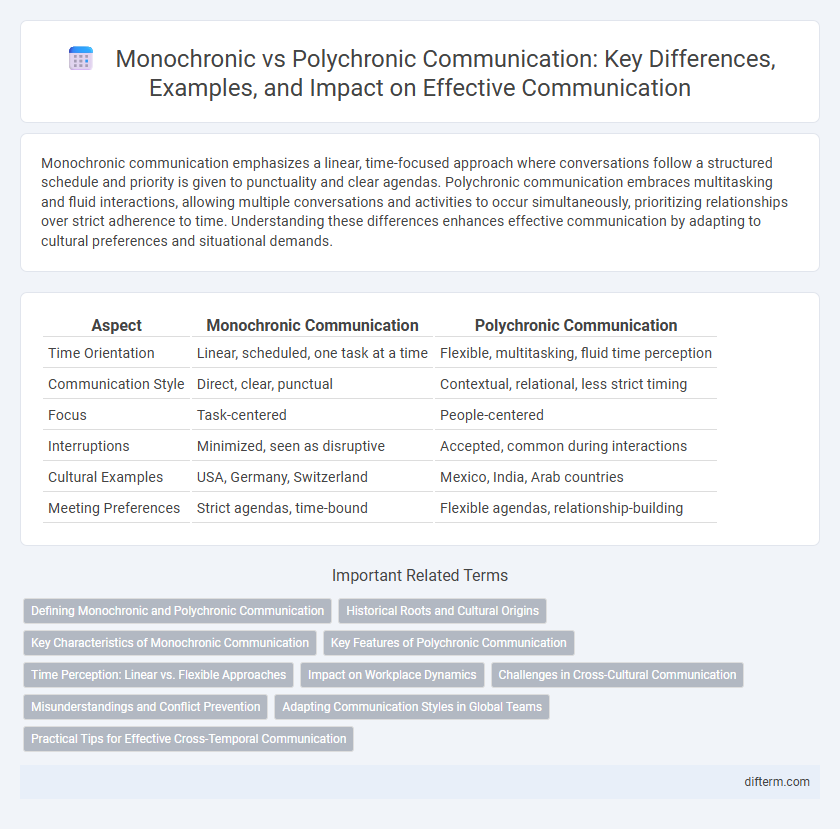Monochronic communication emphasizes a linear, time-focused approach where conversations follow a structured schedule and priority is given to punctuality and clear agendas. Polychronic communication embraces multitasking and fluid interactions, allowing multiple conversations and activities to occur simultaneously, prioritizing relationships over strict adherence to time. Understanding these differences enhances effective communication by adapting to cultural preferences and situational demands.
Table of Comparison
| Aspect | Monochronic Communication | Polychronic Communication |
|---|---|---|
| Time Orientation | Linear, scheduled, one task at a time | Flexible, multitasking, fluid time perception |
| Communication Style | Direct, clear, punctual | Contextual, relational, less strict timing |
| Focus | Task-centered | People-centered |
| Interruptions | Minimized, seen as disruptive | Accepted, common during interactions |
| Cultural Examples | USA, Germany, Switzerland | Mexico, India, Arab countries |
| Meeting Preferences | Strict agendas, time-bound | Flexible agendas, relationship-building |
Defining Monochronic and Polychronic Communication
Monochronic communication emphasizes a linear, structured approach where individuals focus on one task at a time, valuing punctuality and schedules. Polychronic communication involves multitasking and prioritizing relationships over strict adherence to time, allowing simultaneous activities and flexible timelines. Understanding these communication styles is crucial for effective intercultural interactions and managing expectations in diverse environments.
Historical Roots and Cultural Origins
Monochronic communication, rooted in Western industrial societies, emphasizes strict adherence to schedules, punctuality, and linear task completion, reflecting the cultural origins of European time management and efficiency. Polychronic communication, prevalent in many Indigenous, Latin American, and Middle Eastern cultures, originates from social structures that value relationships and multitasking, demonstrating a fluid approach to time where multiple interactions occur simultaneously. These historical roots influence communication styles, shaping how different cultures prioritize time, interaction pacing, and the management of social context.
Key Characteristics of Monochronic Communication
Monochronic communication emphasizes a linear, task-oriented approach where time is segmented into precise, scheduled units and individuals focus on one activity at a time. Key characteristics include punctuality, strict adherence to deadlines, and clear, direct exchanges of information to ensure efficiency. This communication style is prevalent in cultures that value structure, organization, and predictable outcomes.
Key Features of Polychronic Communication
Polychronic communication is characterized by multitasking, where individuals engage in multiple conversations or activities simultaneously without strict adherence to schedules. It emphasizes relationship-building and flexibility, often valuing interpersonal connections over rigid time management. Communication tends to be more fluid and context-driven, with interruptions and shifts in focus considered natural.
Time Perception: Linear vs. Flexible Approaches
Monochronic communication emphasizes a linear perception of time, valuing punctuality, schedules, and sequential task completion, which aligns with cultures that prioritize strict time management and clear deadlines. Polychronic communication adopts a flexible time approach, allowing multitasking and fluid scheduling, often found in cultures where relationships and adapting to changing circumstances take precedence over rigid adherence to time. Understanding these distinct time perceptions enhances cross-cultural communication by aligning interaction styles with audience expectations.
Impact on Workplace Dynamics
Monochronic communication, characterized by sequential task management and strict adherence to schedules, promotes efficiency and clear expectations in the workplace but may reduce flexibility and adaptability. Polychronic communication embraces multitasking and fluid time management, fostering relationship-building and collaboration but possibly causing misunderstandings and time management challenges. Understanding these communication styles helps organizations tailor workflows and improve interpersonal dynamics to enhance productivity and employee satisfaction.
Challenges in Cross-Cultural Communication
Monochronic communication prioritizes strict schedules and one task at a time, while polychronic communication embraces multitasking and flexible time management, posing challenges in cross-cultural interactions. Misunderstandings often arise when monochronic individuals perceive polychronic counterparts as disorganized or disrespectful of time, whereas polychronic communicators may view monochronic approaches as rigid and impersonal. Effective cross-cultural communication requires awareness and adaptation to these differing time orientations to avoid conflicts and improve collaboration.
Misunderstandings and Conflict Prevention
Misunderstandings in monochronic communication often arise due to its emphasis on strict schedules, leading to frustration when polychronic individuals prioritize relationships over punctuality. Polychronic communication, which values multitasking and flexible time, may cause monochronic communicators to perceive a lack of commitment or organization. Conflict prevention requires awareness of these cultural differences, promoting patience and adaptability to bridge communication styles effectively.
Adapting Communication Styles in Global Teams
Monochronic communication emphasizes punctuality, linear task completion, and direct messaging, making it effective in structured environments. Polychronic communication values multitasking, relationship-building, and flexible scheduling, which fosters collaboration in diverse cultural settings. Adapting communication styles in global teams requires awareness of these differences to enhance teamwork, reduce misunderstandings, and improve overall productivity.
Practical Tips for Effective Cross-Temporal Communication
Effective cross-temporal communication requires recognizing that monochronic cultures prioritize strict schedules and sequential task completion, while polychronic cultures favor multitasking and flexible time management. Tailor your communication approach by setting clear deadlines and agendas with monochronic counterparts, and allowing for a conversational flow and relation-building in polychronic interactions. Use explicit time markers and confirm understanding to bridge temporal preferences and enhance collaboration across these cultural differences.
monochronic communication vs polychronic communication Infographic

 difterm.com
difterm.com